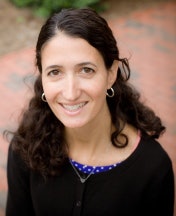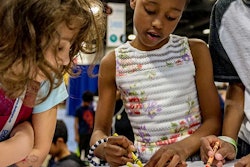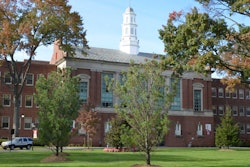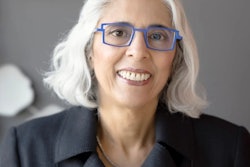 Dr. Kelly Hogan
Dr. Kelly Hogan
Before each class, Hogan’s students receive questions to guide their assigned reading and then log in online to complete graded homework that is designed to prepare them for the next lesson.
The more structured, active-learning model Hogan uses has borne precious academic fruit. A study she co-authored last year found that all her students achieved at higher levels. But some subgroups benefited even more.
Black students cut their achievement gap with Whites in half. It disappeared totally for first-generation students, compared to those whose parents had gone to college.
“The only way to cut an achievement gap is to have a disproportionate benefit for the groups that there is already a gap for. I think that’s significant,” says Hogan, director of instructional innovation in the College of Arts and Sciences at UNC-Chapel Hill.
Those results, published in the CBE-Life Sciences Journal, hold the promise of making progress—at least for Black students at research universities like UNC-Chapel Hill—on the stubborn problem of the achievement gap in STEM courses. Could the teaching style also help increase the retention of students through graduation with degrees in those fields? “We have a glimpse of it, and I think the answer is yes. We need to follow students longitudinally,” Hogan says.
The numbers, too, only reinforce the achievement gap. A 2012 report from the American Council on Education (ACE) found that, within five years of enrolling in college, 74 percent of Asian Americans and 70 percent of Whites earn an academic credential, while only 49 percent of Hispanics and 48 percent of African-Americans do.
Trial and error
Across the varied landscape of higher education, colleges and universities have used many methods to enroll and retain more underrepresented minorities, with some degrees of success. What schools have done depends on the type of institution, its mission and student population, and the commitment of its leadership and faculty, observes Kim Bobby, director of the inclusive excellence group at ACE.
“You are going to find a variety of different types of ways to approach this,” Bobby says.
Those efforts, besides active-learning classes such as Hogan’s, include college-readiness programs for K-12 students, targeted tutoring-mentoring programs, mandatory student orientations, voluntary instructional sessions to supplement college courses and learning communities of students with the same majors.
Hogan says active learning in her biology classes required students to work on their skills and knowledge multiple times before taking an exam. It also made them feel like a community of learners.
“The students are held accountable to practice before they get to class,” Hogan explains. “They are practicing in class with technology and group activities, problem solving. Then they’re asked to practice again after class.”
Not only did Black students make up half the gap in total exam points, but student surveys after the class found that they benefited in other ways.
“In the traditional setting, we found our Black students had what we call a ‘participation gap,’” Hogan says. “They were less likely to participate in classroom discussions, and that gap seems to have completely disappeared with the more structured, interactive classes.”
Hogan adds that Black students were more likely “to say homework was of higher importance” and “report that the skills they learned in the higher-structure course were useful. That does lend to the idea that the practice is really significant for them.”
Black students made up 14 percent of the biology students. Dr. Sarah Eddy, the study’s co-author and a research associate in biology at the University of Washington, says 38 percent of Black students were first-generation college-goers.
Latino students, 10 percent of those enrolled, gained exam points—but, somewhat surprisingly, not enough to close their achievement gap with White students. Hogan suggests that finding “may have something to do with the gap being smaller” for Latino students than for Black students.
Future plans
Overall, UNC-Chapel Hill was so pleased with the study’s results that the active-learning model has been adopted for all the school’s introductory courses in biology, chemistry and physics, says Hogan. At the University of Washington, where the separation measurement focused more on socioeconomic class, the model has also helped all students make academic gains, particularly those from lower socioeconomic groups, explains Eddy.
It is unclear whether such courses will have the same positive effects at community colleges or comprehensive universities. Dr. Scott Freeman, a principal lecturer in biology at the University of Washington, says trials at a half-dozen schools of those types have shown student gains, “but, in each case, it’s too early to tell whether they replicate the disproportionate benefit [to Black and first-generation students].”
Bobby endorses the active-learning model and compared it to a summer “college readiness” program—similar to others across the country—that she set up while working at the University of Puget Sound for diverse students in grades seven through 12 from local schools in Tacoma, Wash.
“It’s an intensive math and science program where students use the equipment. They have access to the computer lab, faculty and students that are in the discipline as their teaching assistants. It has yielded some really solid results [by increasing college-going among participants],” Bobby says.
Students in the summer program explore scientific issues such as water and food quality in their own community, Bobby says, by bringing samples back to the Puget Sound lab and identifying the substances they contain using the kind of spectrometer that they see on the CSI television shows.
“That isn’t lecture. It’s an experiential kind of learning that does have a long-term impact,” Bobby says. “I think it’s important we do those kinds of early outreach experiences because, the first time a student sets foot on a college campus and is embraced as a member of that community, it changes their identity.”
Some community colleges have adopted a different type of targeted program to retain Black students. Those programs, often called Men of Merit or Men of Distinction, provide tutoring and mentoring. But they lack scale, with participants in such groups averaging about two dozen, according to the Center for Community College Student Engagement at The University of Texas at Austin. Instead, the center has recommended that community colleges adopt practices shown to benefit all students, such as making orientation programs mandatory to ensure incoming students become acquainted immediately with what college life is all about.
Another approach, which UNC-Chapel Hill offers, is voluntary supplemental instruction—group tutoring sessions with an instructor and assistants who are high-achieving undergraduates.
“That to me is not equal access because some students may want to go, but they can’t get there because they work or they have some other major conflict,” Hogan says.
As another example, in part by grouping freshmen with the same major into learning communities guided by a professor, the University of Massachusetts Boston has increased the percentage of STEM students who are underrepresented minorities and made progress on retaining them.
Bobby praises the variety of approaches to closing achievement gaps and retaining underrepresented students.
“I think we’re making headway. I think people are sincere in their efforts to do good work, but the population isn’t a snapshot,” Bobby says. “Our student populations and our communities present different ways of being, so we can’t just say we’ve found the silver bullet, because nothing is stagnant.”


















